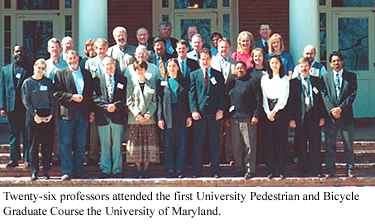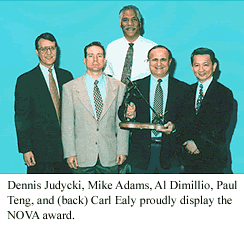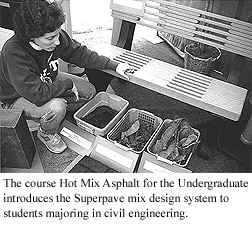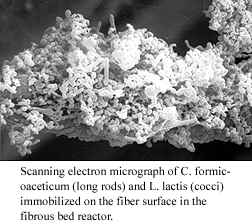U.S. Department of Transportation
Federal Highway Administration
1200 New Jersey Avenue, SE
Washington, DC 20590
202-366-4000
Federal Highway Administration Research and Technology
Coordinating, Developing, and Delivering Highway Transportation Innovations
|
Research & Technology Transporter This newsletter is an archived publication and may contain dated technical, contact, and link information. |
|
| Publication Number: N/A Date: May 1999 |
Publication Date: May 1999
|

The Human Centered Systems Team of RD&T is offering a series of hands-on workshops to promote the recently completed Human Factors Handbook for Advanced Traffic Management System (ATMS) Design. The handbook provides guidance to Traffic Management Center (TMC) design teams on efficient and effective ways to design TMCs, concentrating on design elements of the TMC related to human performance. The handbook provides design guidelines in the areas of human error, human performance, job design, anthropometry and design, display devices, controls and input devices, the work space, the user-computer interface, user aids, and presenting data.
These full-day workshops will be held in various locations around the country this summer. They are aimed at members of the public and private sector. The workshops will introduce the development, organization, contents, and use of the handbook. Presenters explain how to apply the handbook guidelines and how to use the handbook to tackle several real-world problems. Copies of the handbook (FHWA-JPO-99-042) will be available later this spring.
Mark Robinson

Getting accurate and consistent crash data is a key element to improving highway safety. Software has been developed by the Safety Management Team of RD&T that increases the accuracy and consistency of data recorded by police after a crash. Expert system software was designed and developed to provide better data for three safety elements:
Expert knowledge is incorporated in the software so that police are queried for relevant data based on the circumstances of a particular crash. The expert systems intelligently assign a value to a crash data element and reach conclusions that human experts would, based on that same crash evidence. Police can use the expert systems via a seamless interface with a State police report data collection system.
The software was succesfully tested in Iowa. Police officers felt the software was easy to use and fast -- it only took about 2 minutes per expert system to collect the data.
The final report on the software is titled Expert Systems for Crash Data Collection. It is available at www.tfhrc.gov. A technical brief (FHWA-RD-99-052) and an unpublished Transportation Research Board (TRB) paper are also available by contacting the following.
Michael S. Griffith

Every year approximately 6,000 pedestrians and bicyclists are killed in crashes with vehicles. These crashes are the leading cause of death for persons from ages 1 to 44. A comprehensive university graduate course on pedestrian and bicyclists for transportation planning and engineering students has been developed by the Office of Safety R&D
The course material provides future transportation professionals the skills and knowledge to integrate pedestrian and bicycle accommodations into the planning and design of the transportation system. The university course covers an extensive range of issues in non-motorized transportation design, which includes pedestrian and bicycle crash types and countermeasures, pedestrian accommodation at intersections, traffic calming techniques, and bicycle facility design.
In March a forum about the course was attended by 26 professors who develop and teach transportation planning and engineering. The University Pedestrian and Bicyclist Graduate Course was well received. All the professors indicated that they would integrate the course materials into their curriculum, and some indicated they would offer it as a stand alone course. A second forum is being planned for early 2000.
Leverson S. Boodlal

The Construction Innovation Forums Annual NOVA Award was given out in March to recognize the development of the Humboldt Stiffness Gauge (HSG) by FHWA research engineer Al DiMillio, along with Frank Berkman of BBN, Inc., Chuck Nelson of CNA, Inc., and Dennis Burgess of the Humbolt Manufacturing Co. The HSG is a field instrument used to measure soil stiffness and soil modulus without digging into or destroying the existing soil. It measures soil stiffness in about a minute and provides more complete and accurate information than was available previously. Using the HSG eliminates guesswork and the extra design time required for a construction project where soil modulus is unknown. It also saves having to compact soil more than necessary.
The HSG is derived from an Army device used to detect buried land mines. The Advanced Research Programs Administration of the Department of Defense funded the initial study under their Technology Reinvestment Program. Compacted soil is an essential element of highway, airport, building, sewer, and bridge construction.
Al Dimillio

The Innovative Bridge Research and Construction Program (IBRC) provides direction and funding to accelerate the adoption of innovative materials such as high-performance concrete and steel, aluminum, and fiber-reinforced polymers and technologies for bridge repair and construction. This 6-year program, administered by the Office of Bridge Technology, promotes the use of innovative materials and technologies on bridges to reduce maintenance and life-cycle costs, ease construction time and traffic congestion, and increase the ability of bridges to withstand natural disasters, including alternatives for seismic retrofitting. The program also promotes close partnerships with States, localities, and industry in meeting its goals.
The Transportation Equity Act of the 21st Century (TEA-21) funds IBRC technology deployment through research, development, and technology transfer activities and through grants to State DOTs for repair and construction. The total annual grant program ranges from $10 to $20 million. DOTs can nominate bridge projects and use IBRC funding to help defray the cost of incorporating innovative materials in their bridge projects. An important component of IBRC is the opportunity to establish design and evaluation criteria for innovative materials and technologies.
The FY 1998-1999 solicitation for candidate projects attracted 111 nominations. Sixty projects were identified as well-qualified for funding. The FY 2000 solicitation was published April 1, 1999. For information on the IBRC program and projects funded, visit www.fhwa.dot.gov/bridge.
George Romack
A multimedia interactive CD-ROM, Intelligent Transportation Systems Awareness, has been developed by the Office of Operations Technology Services. The CD offers current information in an interactive format. It is based on the Intelligent Transportation Systems (ITS) Professional Capacity Building (PCB) instructor-led ITS Awareness Seminar (FHWA Course # 13601). The seminar has been presented to more than two thousand participants.
Version one of the ITS Awareness CD-ROM was previewed at the Transportation Research Board annual meeting in January 1999 and copies were disseminated to FHWA field offices. Version two is available, and includes the following four modules: (a) Module 1--What are Intelligent Transportation Systems?, (b) Module 2--Success Stories, (c) Module 3--Strategic Considerations, and (d) Module 4BPlanning and Intelligent Transportation Systems.
The ITS Awareness CD-ROM, a self-paced interactive learning tool, comprises video clips, narration, review questions, and hyperlinks to ITS Web sites providing the user with state of the practice information on ITS.
The ITS Awareness CD-ROM was given out at the ITS America annual meeting in April, and distributed to FHWA and Federal Transit Administration field offices. Copies are available for individuals, professional associations and States and local agencies until supplies are depleted. For a copy of the ITS Awareness CD-ROM, please contact:
Patty de Palacios

A new undergraduate course on Superpave is now available through the FHWA Research and Technology Report Center. The course introduces the Superpave mix design system to students majoring in civil engineering. It can be used as a supplement to the asphalt concrete segment of the traditional undergraduate course in civil engineering materials or pavements.
The university course materials include two 50-minute lectures for the sophomore level and twelve 50-minute lectures for juniors. The course information is being made available on a CD-ROM. The class lectures are in Powerpoint format. Instructor's notes, a laboratory instructor's guide, and student's notes, as well as student homework problems, are included. The CD includes a Powerpoint viewer, so software purchase is not necessary.
The CD-ROM is being distributed directly to the AASHTO Subcommittee on Materials, FHWA Local Technical Assistance Program Centers, the Superpave Centers, and to FHWA headquarters and field staff. The FHWA field offices will be asked to distribute the course to State highway agencies and to work with the states to encourage universities and colleges to include the course materials in their curriculums.
To order the "Hot Mix Asphalt for the Undergraduate" CD-ROM (Publication No. FHWA-RD-99-073), contact the FHWA Research and Technology Report Center at (301) 577-0906; or fax (301) 577-1421.
Lee Gallivan

A study by FHWA's Asphalt Team has revealed a new process to develop low-cost calcium magnesium acetate (CMA) deicers from cheap feed stocks such as cheese whey. The use of CMA deicer can help maximize the efficiency of winter maintenance operations and help preserve both the environment and the Nation's highway infrastructure.
CMA is a mixture of calcium acetate and magnesium acetate and has a deicing ability comparable to that of salt. Unlike salt, CMA is noncorrosive to vehicles, not harmful to highway concrete and vegetation, and has no significant health or environmental concerns. Unlike commercially available CMA, which is made from glacial acetic acid and dolomitic lime or limestone, CMA from cheese whey can be produced at highly competitive prices.
The new process calls for the fermentation of cheese whey in a fibrous bed reactor to produce acetate from lactose. The acetic acid is then extracted, recovered, and separated from the fermentation broth.
Acetate can be efficiently produced from whey (lactose) using an anaerobic mixed culture of homolactic and homoacetic bacteria. Production of acetate from currently unused liquid whey could provide 0.77 million tonnes (~1.7 billion pounds) per year of low-cost CMA and potassium acetate (KA) for highway and airport runway deicing materials.
Deicing tests have shown that CMA samples from fermentation and extraction have an equal or slightly better ice penetration rate than that of commercial CMA. Cost analysis shows that CMA can be produced at a production cost of $224 to $360/tonne, less than 30 percent of the current market price for commercial CMA.
The results of this study are fully documented in a new report (FHWA-RD-98-174) titled Calcium Magnesium Acetate at Lower Production Cost: Production of CMA Deicer from Cheese Whey.
Brian Chollar
In order to prepare highway engineers to better mitigate noise pollution, a new video has been produced on Acoustics and Your Environment - the Basics of Sound and Highway Traffic Noise. The video was produced for FHWA by the Volpe National Transportation Systems Center Acoustics Facility It is an educational tool that presents the fundamentals of sound and highway traffic noise. The video thoroughly explains traffic noise analysis for residents immediately adjacent to a proposed noise barrier.
The video is approximately 48 minutes long and has two parts. Part 1 covers the basics of sound, including:
Part 2 covers the basics of highway traffic noise, including:
A copy of the video and the script for the video was distributed to FHWA field offices and State DOTs. The video is available from FHWA at (202) 366-2078, the Volpe Center at (617) 494-2372, or NTIS at (800) 553-NTIS (video # AVA20426VNB1).
Steve Ronning